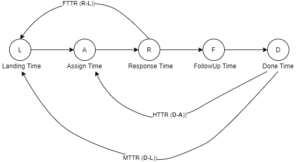OVERVIEW
Customer experience management (CxM requires companies to have a trifles view of customers, and this process requires a lot of effort, and where you give efforts having a track measurement of your CxM effort & output is a must, without any further delay let’s jump on the key points.
Why It’s required:
- To measure social media team SLA
- To measure the team’s work distribution
- To manage the KPI
- To find the scope & lackings.
- Agent-based SLA calculation
- Teamwise calculation And many more
THINGS TO CONSIDER
- QUANTITATIVE MEASUREMENT- Here we get the quantitative measurement but please be noted that there always exists a qualitative measurement.
- FIRST RESPONSE TIME – The first time to respond to your customer can be different depending on the industry. FTTR can be 3 minutes to 15 minutes Considering the industry. Ex: The first time to respond in a service-based company or retail consumers may take 3 minutes but for a car company it may take 15 minutes.
- HTTR DIFFERENCE – The process of responding to your customer and ticket closing varies according to the industry. Lead-based industries where they do QMS to LMS & need to hold the tickets to nurture their lead for them the time to close the ticket may take 1 month.
FEATURE
What is FTTR, MTTR, HTTR?
Definitions:
- FTTR – First Time To Response
- MTTR – Median Time To Response
- HTTR – Handling Time To Response
Concept Clarification
- FTTR = Response Time – Landing Time; R – L
- MTTR = Done Time – Landing Time; D – L
- HTTR = Done Time – Assign Time; D – A
Now What is Landing Time?
- Facebook Posted Time. i.e: The exact Facebook time of Comment/Reply/Message

Deployed in CommEngine


You can view your analytics in the dashboard & Reporting as
- Daily
- Weekly
- Monthly
- Feed-wise
- Inbox-Wise
- Feed & inbox total
Time Representation
00: 00: 00 OR 00: 00: 00: 00
↑ ↑ ↑ ↑ ↑ ↑ ↑
HH: MM: SS DD: HH: MM: SS
